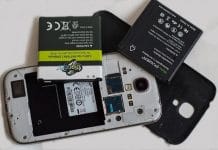
Lithium-ion battery technology is considered one of the latest cutting-edge breakthroughs in the world of alternative power source industry. This is a definite and evident fact because almost all of the gadgets and gizmos that people use today are powered by this kind of battery.
From smartphones to laptops, all the way to cordless power tools and battery-operated scooters and other related equipment. However, regardless of its benefits and drawbacks, debates are still ongoing concerning its proper maintenance.
Is it OK to leave a Lithium Ion battery on the charger? This is a tricky question to answer. However, the best answer to this question is, it depends on several factors within the situation. Factors involved include the kind of lithium ion battery to be charged, the type of charger to be used, and ambient temperature.
Some battery experts say that it is not OK to leave a lithium-ion battery on the charger, because it may give the cell a certain amount of strain. The strain that may lead to a quicker deterioration of its plates will eventually result in its death.
On the other hand, there are also some battery experts that say leaving a lithium ion battery on the charger is OK. These experts say that it’s OK to leave a li-ion battery on the charger because this is a battery designed to operate safely under its specified voltage for operation.
It is also OK because most of the chargers today are designed to have smart technology that allows them to stop the charging process once the battery reaches 100%. Modern chargers today also have a trickle charge mode that will enable them to only top up the battery when it is fully charged.
For this guide, our answer will rely on the situation and the factors that are involved. This is because, in real life, most people charge a lithium-ion battery without thinking about the elements that revolve around the charging process of the battery. This means that in most cases, people are charging a lithium-ion battery without knowing if the cell does or doesn’t have a BMS function.
It is also true for chargers. People charge their lithium ion cells, not knowing if the charger they use can trickle charge or not. So, we think the best answer to that question will ultimately rely on the circumstances and the factors that will come into play.
Here I am going to talk about everything about lithium-ion. I will tackle anything related to lithium-ion batteries, from its components, how it works, all the way to its charging information. I am also tackling the benefits and drawbacks of this type of power cell.
And along with all these, I will also provide you with a list of the good practices that will help keep your lithium-ion battery in top shape. A well-maintained li-ion battery will offer longer service life and optimum performance and longer runtime.
The Complete Anatomy of a Lithium-Ion Power Cell
Lithium-based power cells, commonly referred to as lithium-ion batteries come in a variety of types. However, they are mainly built with the same core battery components that I have listed below.
● Positive Electrode (Cathode): Generates lithium ions that dictates the battery’s capacity.
● Negative Electrode (Anode): Responsible for storing and releasing ions to deliver power.
● Electrolyte: Catalyst that generates the movement of ions from one electrode to another.
● Separator: Acts as the barrier that prevents the electrodes from coming in contact.
Those are the major components of a lithium-ion battery that are essential and vital to its functionality. Without any of those elements, the lithium-ion battery won’t work or operate, because each of these crucial components relies on each other for them to work.
How Lithium-Ion Batteries Work or Operate
Like any kind of battery, lithium-ion power cells by converting chemical energy to electrical energy that will be released as current. Once a lithium-ion battery is connected to complete a circuit, a chemical reaction will be triggered within the battery. While this chemical reaction is taking place, a buildup of electrons will occur on the battery’s negative electrode.
These electrons will then be attracted to the positive electrode since it is less congested. This will cause the electrons to travel through the battery electrolyte, finding their way through the circuit to the positive electrode, powering any load within the circuit in the process. While all of this is taking place, the lithium ions with positive charge left behind also travel through the electrolyte to meet the electrons on the positive electrode.
In the case of a charging lithium ion battery, where it is the one receiving an input. The process is reversed. Once the battery is plugged into a power source, the current will force the electrons from the positive electrode to go to the negative electrode. These electrons will then stay on that side until the battery needs to power up something again.
With this, the lithium-ion battery (how long it can deliver a sustainable power) is determined by the number of lithium ions the anode and cathode can accommodate as the battery undergoes the series of continuous charge to discharge cycles.
The positive (cathode) and negative (anode) electrodes will gradually deteriorate, reducing the number of ions they can accommodate little by little. This eventually leads to lost battery capacity until it reaches the peak of its service life.
A Deeper and Closer Look at the Charging Information of Li-ion Batteries
In this part, I will take a closer look at the charging information of lithium-ion batteries and what transpires during the charging process. I will also discuss how these power cells different from other types when it comes to charging operations.
Chargers for lithium-based batteries are devices built with voltage-limiting capabilities with several similarities with the lead-acid charging system. What makes the lithium a lot different is the dense voltage tolerance that allows the accommodation of larger amounts of voltage on each cell of the batteries.
Lithium-ion battery chargers also don’t have a float and trickle charging modes once 100% fully charged state is reached. The main reason behind this is that lithium ions can not take up overcharging; this is a battery technology that only takes what it needs.
The charging process of lithium-ion batteries is a dual-stage operation to ensure that no overcharging or any issue occurs. The first half of charging the battery will take place until the battery is 70% recharged. Upon reaching this amount of charge, the second half of the process will kick in to take place until the battery reaches the 100% charged state.
Let’s take a closer look at these two halves of the operation to get a better understanding.
1. Steady Flow of Electricity for Large Amounts of Charge
The first half of the part process of charging a lithium ion battery is all about feeding the battery as much charge as it can take. In this stage of charging, there is a steady flow of current or electricity to replace the amount of discharge as quickly as possible.
In this charging stage, the charger is the one deciding how much power will feed the battery. The larger the amount of current that consistently flows, the faster the cell will reach the 70% charge level.
2. Consistent and Constant Charging Based on Voltage
The second half of the charging process, which will take place as soon as the 70% charge level is reached, is an operation that maintains constant voltage for charging. At this stage of charging the lithium ion battery, the charger keeps track of the voltage because the current the battery receives is based on the charger’s maintained voltage.
It only means that the current battery is reduced as it approaches the fully charged state. Then after the battery reaches the 100% charge state, the charger will stop the charging operation and standby. As the battery discharges itself, the charger will then trickle in just to compensate for the lost charge.
Good Practices to Take Good Care of a Lithium Ion Battery
You now have a proper understanding of lithium-based power cells after receiving a ton of excellent and reliable information about lithium-ion batteries. This enables you to see through lithium-ion batteries and identify their weaknesses and strengths, allowing you to have some ideas on how you can take proper care for your batteries.
It will also allow you to gain the essential knowledge that you need to somehow keep your lithium-ion batteries in shape and optimize their service life.
In addition to your newly learned knowledge of lithium ion batteries. This guide will also help you keep your li-ion batteries in shape by providing a list of the good practices that will help you take good care of your lithium-ion batteries.
Check them out and take some notes!
1. Charging the Lithium-Ion Power Cell the Proper Way
As I mentioned earlier, lithium-ion batteries have a clean system that does not allow it to take overcharging. I also established earlier that leaving the battery plugged into a charger may be or not be OK with these batteries depending on the situation.
However, if you are using the original charger of the device, then that would be OK, because original chargers of devices are designed to be perfectly compatible with the device.
But here, the point is to properly charge your battery, if that is consistently done, your lithium-ion battery will have a great chance to last longer.
2. Never Let Lithium-Ion Batteries to be Completely Discharged
Lithium-ion batteries are also designed to have a more optimized battery life when it is not charged or drained completely. They are more well-adapted in taking a bit of charge once in a while.
So, a lot of battery experts suggest that charging lithium-ion power cells will more likely optimize their service life. It will also keep them in top shape for better performance that will put a smile on every user’s face.
3. Always Keep Your Lithium-Ion Batteries Cool
Heat is the number one kryptonite of lithium-ion power cells. Yes, they perform exceptionally well in high temperatures, but doing so also takes a lot of toll on their health.
The best way to take good care of your lithium-based cells is to always keep them cool all the time. Store them in place with cooler ambient temperatures and then charge them when the temperature of the environment is at reasonable and room temperature levels.
This will lessen the strain on the battery that allows them to have a long-lasting service life. This is because their plates will have a longer time to accommodate and store charges.
4. Never Store a Lithium-Ion Battery with No Charge
For lithium-based batteries that are not used daily and have to be stored for more extended time periods, you have to keep in mind that you can’t store them completely drained.
A completely drained lithium-ion battery stored will severely damage its plates because of its rate of self-discharge. It has a 5% self-discharge rate on the first 24 hours of being stored, and it will change to 1% to 2% thereafter.
This self-discharge rate will weaken the battery plates if the battery is stored without any charge left in it. The ideal thing to do is you have to store a lithium-ion for a long time; the battery has to have at least a 40% or 50% charge.
Those are the safety and good practices that you have to keep in mind if you want to prolong your lithium-ion batteries. The essential important thing is to make sure you understand the entire anatomy of the lithium-ion technology.
This will enlighten you about the bad things for their health and then give you ideas on how to preserve their service life and allow you to make them last longer.
Final Thoughts
There you go! All the information that you need to know about the lithium-ion battery technology was already given throughout the guide. We hope that these details about the battery technology will be able to help you in any kind of way.





